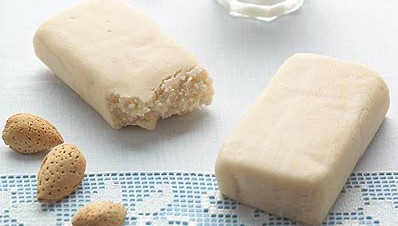[banner]
” Perhaps the oldest and most famous preparation made with this paste is the Martorana Fruit, which was officially born in Palermo, in the convent attached to the church erected in 1143 by George of Antioch , senior officer of the king. The nuns used to make small cakes with marzipan for the day of All Saints, which reproduced every kind fruits with bright colors , achieved thanks to the Arabic gum which was used to fix the vegetable dyes derived from rose , saffron, pistachio etc. . The paste was also called ” royal paste” as worthy of a king, in this case the Norman king Roger II of Sicily.
In 1193 approx. the noblewoman Eloisa Martorana built a Benedictine monastery next to the church and the convent , and so in her honor ,both the building and the sweets prepared by the nuns took the name ” Martorana ” . As time passed by, every religious festival earned a special marzipan subject: for example: sheep were for Christmas , horses for St. Anthony, and lambs for Easter.
The success of these sweets pushed the corporation of “Confettari” (people who make Confetti) to try to gain the monopoly of their production. The goal was reached in 1575 with the intervention of the diocesan synod of Mazara del Vallo , which forbade the nuns to prepare the Fruit of Martorana because it took time to the recollection of the liturgy. ”
In the Sicilian tradition, almond paste is used to create the typical fruits of the period of All Saints, the Easter sheep (in Sicily they even sell the plaster molds to create them), and they also cut it into rectangles and color it in green to make the Cassata or other delicious tea biscuits. Its preparation is very simple and is given by three simple ingredients :
Almond flour and powdered sugar in equal parts with the addition of a little water.
Procedure:
1 Begin to knead the almond flour and the powdered sugar .
2 Gradually add the cold water continuing to knead until it becomes a smooth paste . The almond flour, reacts to the heat of the hands becoming more oily , so
3 be careful not to use too much water, but if the paste will seem too wet you can always add more almond flour until the consistency will not satisfy you .
You should remember that unlike the sugar paste or mmf, almond paste is more grainy and not elastic, so its processing can be a little more difficult , but nothing it’s impossible, and with a little imagination you can use it to create all the shapes you want.
To color it you can use both gel and powder colors; use the last dissolving them in a little water and brushing as if you were painting.
Below you will find a couple of ideas on how to use it.

Translated by
Versione italiana: http://gustosetraduizioni.altervista.org/
In English: http://gustosetraduizioni.altervista.org/tastytranslations.html
